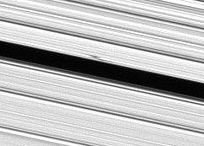






Amoonlet, minor moon, minor natural satellite, or minor satellite is a particularly small natural satellite orbiting a planet, dwarf planet, or other minor planet.
Up until 1995, moonlets were only hypothetical components of Saturn's F-ring structure, but in that year, the Earth passed through Saturn's ring plane. The Hubble Space Telescope and the European Southern Observatory both captured objects orbiting close or near the F-ring. In 2004, Cassini caught an object 4–5 kilometers in diameter on the outer ring of the F-ring and then 5 hours later on the inner F-ring, showing that the object had orbited.[1]
Several different types of small moons have been called moonlets:
|
| |||||||
|---|---|---|---|---|---|---|---|
Listed in approximately increasing distance from Saturn | |||||||
| Ring moonlets |
| ||||||
| Ring shepherds |
| ||||||
| Other inner moons |
| ||||||
| Alkyonides |
| ||||||
| Large moons (with trojans) |
| ||||||
| Inuit group (12) |
| ||||||
| Gallic group (7) |
| ||||||
| Norse group (100) |
| ||||||
| Outlier prograde irregular moons |
| ||||||
| |||||||